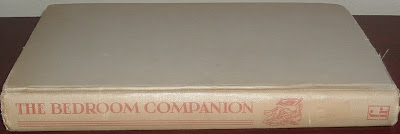 Well, I didn't expect to find Dr. Seuss here: The Bedroom Companion (Farrar & Rinehart, 1935), a compilation of risque humor aimed at sex and the sexes.
Well, I didn't expect to find Dr. Seuss here: The Bedroom Companion (Farrar & Rinehart, 1935), a compilation of risque humor aimed at sex and the sexes. As I thumbed through the book, getting a sense of what passed for risque in the 1930s, a comical illustration caught my attention. Its style was very familiar, but oddly out-of-place. Scanning the bottom of the image for the artist's signature, I was surprised to find what I think I already knew--the illustrator was Dr. Seuss!

What was he doing contributing a humorous illustration about a grown woman's sexual desire and a young boy's inability to do anything about it while the two are stranded on a deserted island? The famous children's author-illustrator contributed this kind of material to a compilation that included in its run-on subtitle the words, A Steaming Bracer for the Forgotten Male.

Well, he wasn't the famous Dr. Seuss yet. This was during the Great Depression and Theodor Seuss Geisel was making a living by his wits and artistic talent. The fame with children's books would come later. I grew up with some of the now classic children's books, such as The Cat in the Hat, from Dr. Seuss. Until now, I had no concept of this Darker Seuss.
I searched the rest of the book for more Dr. Seuss illustrations and found just one more, shown below, revealing the salacious thoughts of a couple of male birds admiring a female cuckoo in a clock.

I thought these comic drawings, collectively, must be one of his earliest appearances in a book, if not the very first.
Reading Geisel's biography at a Web site about Dr. Seuss' art (drseussart.com), I found a reference about the first books he illustrated, Boners and More Boners, which dealt with school children's missteps with language. No publication date was provided, but this reference did remind me that I had also referenced these books in a post on this blog nearly three years ago--From Beowulf to Virginia Woolf. The date I provided was 1931 and I verified that easily with a number of online booksellers.
So The Bedroom Companion is not his earliest appearance in book form, but it is still an early appearance in that format and the earliest I can find for illustrations not intended for a young audience.
The first book he published was And to Think That I Saw It on Mulberry Street in 1937, two years after The Bedroom Companion came out. Prior to that, his work, aside from the Boners books and The Bedroom Companion, appears to have been writing and illustrating ad copy for corporations and humor magazines.
How the editors of The Bedroom Companion tapped Geisel for a few contributions of sexual innuendo is a mystery to me at present. But The Bedroom Companion just might have the honor of being the first appearance of such adult audience (bawdy or otherwise) material in book form by this writer and illustrator known and loved the world over for his children's books.
What a great find! And kudos to you for resisting the obvious double entendre with the title of "Boners" book...
ReplyDeleteThanks, Nancy. As for resistance to double entendre, dare I say it wasn't hard? It was too obvious and over the top to comment on. Plus, I sort of did in the other post I mentioned where I discovered the Boners books. So I decided to leave it at that, though a little temptation did creep in!
ReplyDeleteRojan would have been proud!!
ReplyDeleteNow that I have some idea of who Rojan was (thanks to you), I'm inclined to agree. I thought the dirty-thirties had something to do with Dust Bowl...
ReplyDeleteI have a copy of this book. How could I find the value of it?
ReplyDeleteSome search engines that might be useful to you include bookfinder.com, abebooks.com (select Advanced Search), or marelibri.com (select Advanced Search).
ReplyDelete